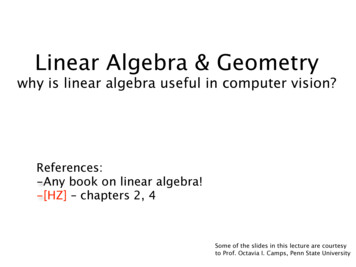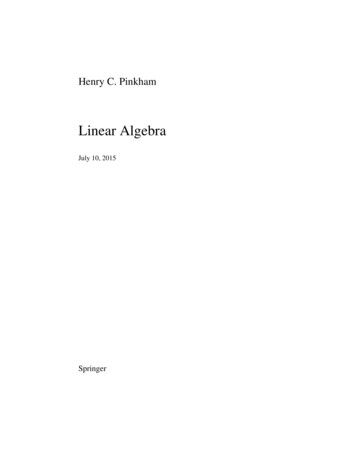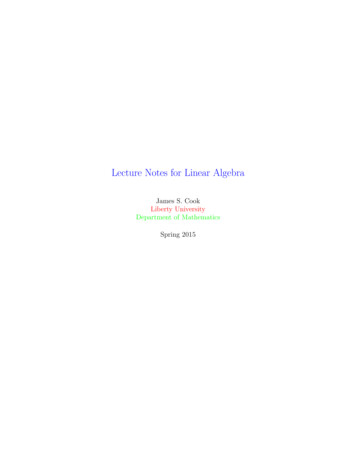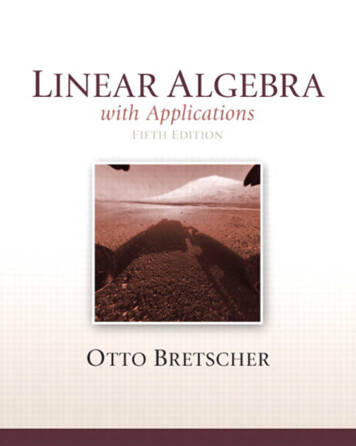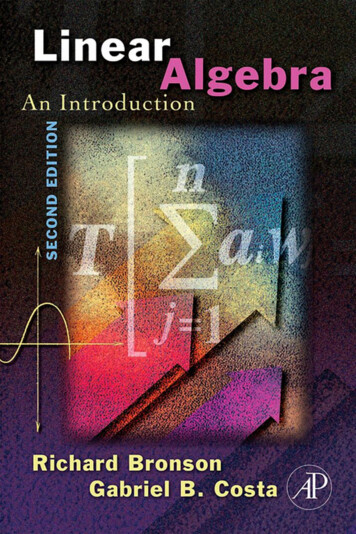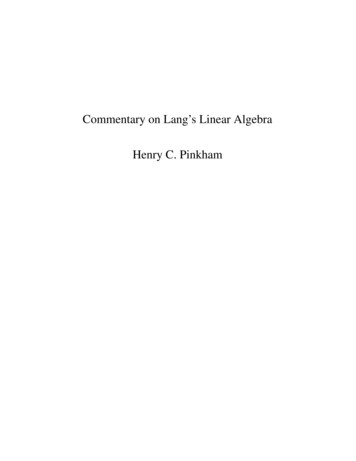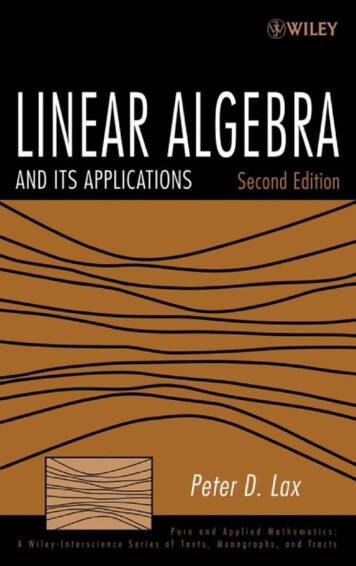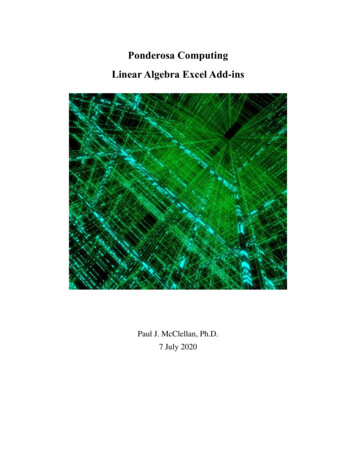
Transcription
Linear Algebra SummaryBased on Linear Algebra and its applications by David C. Lay
PrefaceThe goal of this summary is to offer a complete overview of all theorems and definitionsintroduced in the chapters of Linear Algebra and its applications by David C. Lay thatare relevant to the Linear Algebra course at the faculty of Aerospace Engineering at DelftUniversity of Technology. All theorems and definitions have been taken over directly fromthe book, whereas the accompanying explanation is sometimes formulated in my own words.Linear Algebra might seem more abstract than the sequence of Calculus courses that arealso taken in the first year of the Bachelor of Aerospace Engineering. A great part of thecourse consists of definitions and theorems that follow from these definitions. An analogymight be of help to your understanding of the relevance of this course. Imagine visitinga relative, who has told you about a collection of model airplanes that are stored in hisor her attic. The aerospace enthusiast you are, you insist on taking a look. Upon arrivalyou are exposed to a complex, yet looking systematic, array of boxes and drawers. Theamount of boxes and drawers seems endless, yet your relative knows exactly which containthe airplane models. Having bragged about your challenging studies, the relative refuses totell you exactly where they are and demands that you put in some effort yourself. However,your relative explains you exactly how he has sorted the boxes and also tells you in whichbox or drawer to look to discover the contents of several other boxes.A rainy afternoon later, you have completely figured out the system behind the order of theboxes, and find the airplane models in the first box you open. The relative hints at a friendof his, whose father also collected aircraft models which are now stored in his basement.Next Sunday you stand in the friend’s basement and to your surprise you figure out that hehas used the exact same ordering system as your relative! Within less than a minute youhave found the aircraft models and can leave and enjoy the rest of your day. During a familydinner, the first relative has told your entire family about your passion about aerospace,and multiple others approach you about useful stuff lying in their attics and basement. Apparently, the ordering system has spread across your family and you never have to spend aminute too long in a stale attic or basement again!That is were the power of Linear Algebra lies: a systematic approach to mathematical operations allowing for fast computation.Enjoy and good luck with your studies.1
Contents1 Linear Equations in Linear Algebra1.1 Systems of linear equations . . . . . . .1.2 Row reduction and echelon forms . . . .1.3 Vector equations . . . . . . . . . . . . .1.4 The matrix equation Ax b . . . . . .1.5 Solution sets of linear systems . . . . . .1.6 Linear Independence . . . . . . . . . . .1.7 Introduction to Linear Transformations1.8 The Matrix of a Linear Transformation.33579111214152 Matrix algebra2.1 Matrix operations . . . . . . . . . . . .2.2 The Inverse of a Matrix . . . . . . . . .2.3 Characterizations of Invertible Matrices2.4 Subspaces of Rn . . . . . . . . . . . . .2.5 Dimension and Rank . . . . . . . . . . .1818212425283 Determinants3.1 Introduction to Determinants . . . . . . . . . . . . . . . . . . . . . . . . . . .3.2 Properties of Determinants . . . . . . . . . . . . . . . . . . . . . . . . . . . .3.3 Cramer’s rule, Volume and Linear Transformations . . . . . . . . . . . . . . .313132344 Orthogonality and Least Squares4.1 Inner Product, Length, and Orthogonality4.2 Orthogonal Sets . . . . . . . . . . . . . . .4.3 Orthogonal Projections . . . . . . . . . .4.4 The Gram-Schmidt Process . . . . . . . .4.5 Least-Squares Problems . . . . . . . . . .4.6 Applications to Linear Models . . . . . . .373740424445465 Eigenvalues and Eigenvectors5.1 Eigenvectors and Eigenvalues . . . . .5.2 The Characteristic Equation . . . . . .5.3 Diagonalization . . . . . . . . . . . . .5.4 Complex Eigenvalues . . . . . . . . . .5.5 Applications to Differential Equations.494950515455.6 Symmetric Matrices and Quadratic Forms596.1 Diagonalization of Symmetric Matrices . . . . . . . . . . . . . . . . . . . . . . 596.2 Quadratic Forms . . . . . . . . . . . . . . . . . . . . . . . . . . . . . . . . . . 602
Linear Equations in Linear Algebra1.1 Systems of linear equationsA linear equation is an equation that can be written in the form:a1 x1 a2 x2 . an xn bwhere b and the coefficients an may be real or complex. Note that the common equationy x 1 describing a straight line intercepting the y-axis at the point (0, 1), is a simpleexample of a linear equation of the form x2 x1 1 where x2 y and x1 x.A system of one or more linear equations involving the same variables is called a system oflinear equations. A solution of such a linear system is a list of numbers (s1 , s2 , ., sn )that satisfies all equations in the system when substituted for variables x1 , x2 , ., xn . Theset of all solution lists is denoted as the solution set.A simple example is finding the intersection of two lines, such as:x2 x1 1x2 2x1For consistency we write above equations in the form defined for a linear equation:x2 x1 1x2 2x1 0Solving gives one the solution set (1, 2). A solution can always be validated by substitutingthe solution for the variables and find if the equation is satisfied.To continue on our last example, we also know that besides an unique solution (i.e. theintersection of two or more lines) there also exists the possibility of two ore more lines beingparallel or coincident, as shown in figure 1.1. We can extent this theory for a linear systemcontaining 2 variables to any linear system and state thatA system of linear equations has1. no solution, or2. exactly one unique solution, or3. infinitely many solutions31
1.1. SYSTEMS OF LINEAR EQUATIONSFigure 1.1: A linear system with no solution (a) and infinitely many solutions (b)A linear system is said to be consistent if it has one or infinitely many solutions. If asystem does not have a solution it is inconsistent.Matrix notationIt is convenient to record the essential information of a linear system in a rectangular arraycalled a matrix. Given the linear system:x1 2x2 x3 02x2 8x3 8 4x1 5x2 9x3 9We can record the coefficients of the system in a matrix as: 1 21 02 8 459Above matrix is denoted as the coefficient matrix. Adding the constants b from the linearsystem as an additional column gives us the augmented matrix of the system: 1 210 02 88 459 9It is of high importance to know said difference between a coefficient matrix and an augmented matrix for later definitions and theorems.The size of a matrix is denoted in the format m n where m signifies the amount of rowsand n the amount of columns.Solving a linear systemFirst we define the following 3 elementary row operations:1. (Replacement) Replace a row by the sum of itself and the multiple of another row2. (Interchange) Interchange two rows4
1.2. ROW REDUCTION AND ECHELON FORMS3. (Scale) Scale all entries in a row by a nonzero constantTwo matrices are defined as row equivalent if a sequence of elementary row operationstransforms the one in to the other.The following fact is of great importance in linear algebra:If the augmented matrices of two linear systems are row equivalent, the two linearsystems have the same solution set.This theorem grants one the advantage of greatly simplifying a linear system using elementary row operations before finding the solution of said system, as the elementary rowoperations do not alter the solution set.1.2 Row reduction and echelon formsFor the definitions that follow it is important to know the precise meaning of a nonzerorow or column in a matrix, that is a a row or column containing at least one nonzeroentry. The leftmost nonzero entry in a matrix row is called the leading entry.DEFINITIONA rectangular matrix is in the echelon form if it has the following three properties:1. All nonzero rows are above any rows of all zeros2. Each leading entry in a row is to the right of the column of the leading entryof the row below it3. All entries in a a column below a leading entry are zeros 0 0 0 0 0 0 0 0 0 Above matrix is an example of a matrix in echelon form. Leading entries are symbolized by and may have any nonzero value whereas the positions may have any value, nonzero orzero.DEFINITIONWe can build upon the definition of the echelon form to arrive at the reducedechelon form. In addition to the three properties introduced above, a matrixmust satisfy two other properties being:1. The leading entry in each row is 12. All entries in the column of a leading entry are zero5
1.2. ROW REDUCTION AND ECHELON FORMSExtending the exemplary matrix to the reduced 1 0 0 1 0 0 00 0 0echelon form gives us: 0 0Where may be a zero or a nonzero entry. We also find that the following theorem must hold:Theorem 1Uniqueness of the Reduced Echolon FormEach matrix is row equivalent to only one reduced echelon matrix.Pivot positionsA pivot position of a matrix A is a location in A that corresponds to a leading 1 in thereduced echelon form of A. A pivot column is a column containing a pivot position. Asquare ( ) denotes a pivot position in matrix 1.2.Solutions of linear systemsA reduced echelon form of an augmented matrix of a linear system leads to an explicitstatement of the solution set of this system. For example, row reduction of the augmentedmatrix of an arbitrary system has led to the equivalent unique reduced echelon form: 1 0 5 1 0 11 4 0 00 0There are three variables as the augmented matrix (i.e. including the constants b of thelinear equations) has four columns, hence the linear system associated with the reducedechelon form above is:x1 5x3 1x2 x3 40 0The variables x1 and x2 corresponding to columns 1 and 2 of the augmented matrix arecalled basic variables and are explicitly assigned to a set value by the free variableswhich in this case is x3 . As hinted earlier, a consistent system can be solved for the basicvariables in terms of the free variables and constants. Carrying out said operation for thesystem above gives us: x1 1 5xx3 x2 4 x3 x3 is free6
1.3. VECTOR EQUATIONSParametric descriptions of solution setsThe form of the solution set in the previous equation is called a parametric representationof a solution set. Solving a linear system amounts to finding the parametric representationof the solution set or finding that it is empty (i.e. the system is inconsistent). The convention is made that the free variables are always used as parameters in such a parametricrepresentation.Existence and Uniqueness QuestionsUsing our the previously developed definitions we can introduce the following theorem:Theorem 3Existence and Uniqueness TheoremA linear system is consistent only if the rightmost column of the augmented matrixis not a pivot column: the reduced echelon form of the of the augmented matrixhas no row of the form:[0. 0b] with b nonzeroIf a linear system is indeed consistent it has either one unique solution, if there areno free variables, or infinitely many solutions if there is one or more free variable.1.3 Vector equationsVectors in R2A matrix with only one column is referred to as a column vector or simply a vector. Anexample is: u1u u2where u1 and u2 are real numbers. The set of all vectors with two entries is denoted by R2 .(similar to the familiar x-y coordinate system)The sum of two vectors such a u and v is obtained as: u1v1u1 v 1u v u2v2u2 v 2Given a real number c and a vector u, the scalar multiple of u by c is found by: u1cu1cu c u2cu2The number c is called a scalar.7
1.3. VECTOR EQUATIONSFigure 1.2: Geometrical representation of vectors in R2 as points and arrowsVectors in RnWe can extend the discussion on vectors in R2 to Rn . If n is a positive integer, Rn denotesthe collection of all ordered lists of n real numbers, usually referred to as n 1 matrices: u1 u2 u . . unThe vector whose entries are all zero is called the zero vector and is denoted by 0. Theaddition and multiplication operations discussed for R2 can be extended to Rn .TheoremAlgebraic Properties of RnFor all u, v in Rn and all scalars c and d:(i) u v v u(v) c(u v) cu cv(ii) (u v) w u (v w)(vi) (c d)u cu du(iii) u 0 0 0 u(vii) c(du) cdu(iv) u ( u) u u 0(viii) 1u uLinear combinationsGiven vectors v1 , v2 , ., vp and weights c1 , c2 , . . . , cp we can define the linear combinationy by:y c1 v1 c2 v2 . cp vpNote that we can reverse this situation and determine whether a vector y exists as a linearcombination of given vectors. Hence we would determine if there is a combination of weightsc1 , c2 , . . . , cp that leads to y. This would amount to us finding the solution of a n (p 1)matrix where n is the length of the vector and p denotes the amount of vectors available to8
1.4. THE MATRIX EQUATION AX Bthe linear combination. We arrive at the following fact:A vector equationx1 a1 x2 a2 . xn an bhas the same solution as the linear system whose augmented matrix is[a1a2. anb]In other words, vector b can only be generated by a linear combination of a1 , a2 , ., anif there exists a solution to the linear system corresponding to the matrix above.A question that often arises during the application of linear algebra is what part of Rncan be spanned by all possible linear combinations of vectors v1 , v2 , ., vp . The followingdefinition sheds light on this question:DEFINITIONIf v1 , ., vp are in Rn then the set of all linear combinations of v1 , ., vp is denotedas Span{v1 , ., vp } and is called the subset of Rn spanned by v1 , ., vp .That is,Span{v1 , ., vp } is the collection of all vectors that can be written in the form:c1 v1 c2 v2 . cp vpwith c1 , ., cp scalars.Figure 1.3: Geometric interpretation of Span in R3Let v be a nonzero vector in R3 . Then Span{v} is the set of all scalar multiples of v, whichis the set of points on the line through 0 and v in R3 . If we consider another vector u whichis not the zero vector or a multiple of v, Span{u, v} is a plane in R3 containing u, v and 0.1.4 The matrix equation Ax bWe can link the ideas developed in sections 1.1 and 1.2 on matrices and solution sets to thetheory on vectors from section 1.3 with the following definition:9
1.4. THE MATRIX EQUATION AX BDEFINITIONIf A is a m n matrix, with columns a1 , a2 , ., an and if x is in Rn then the productof A and x, denoted as Ax, is the linear combination of the columns of A using thecorresponding entries in x as weights; that is, x1 x2 Ax [a1 , a2 , ., an ] . x1 a1 x2 a2 . xn an . xnAn equation of the form Ax b is called a matrix equation*. Note that such a matrixequation is only defined if the number of columns of A equals the number of entries of x.Also note how we area able to write any system of linear equations or any vector equationin the form Ax b. We use the following theorem to link these concepts:THEOREM 3If A is a m n matrix with columns a1 , ., an and b is in Rm , then the matrixequationAx bhas the same solution set as the vector equationx1 a1 . xn an bwhich has the same solution set as the system of linear equations whose augmentedmatrix is[a1 . an b]The power of the theorem above lies in the fact that we are now able to see a system oflinear equations in multiple ways: as a vector equation, a matrix equation and simply asa linear system. Depending on the nature of the physical problem one would like to solve,one can use any of the three views to approach the problem. Solving it will always amountto finding the solution set to the augmented matrix.Another theorem is introduced, composed of 4 logically equivalent statements:THEOREM 4Let A be a m n matrix, then the following 4 statements are logically equivalent(i.e. all true or false for matrix A):1. For each b in Rm , the equation Ax b has a solution2. Each b is a linear combination of the columns of A3. The columns of A span Rm4. A has a pivot position in every rowPROOF Statements 1, 2 and 3 are equivalent due to the definition of Rm and the matrixequation. Statement 4 requires some additional explanation. If a matrix A has a pivotposition in every row, we have excluded the possibility that the last column of the augmented matrix of the linear system involving A has a pivot position (one row cannot have10
1.5. SOLUTION SETS OF LINEAR SYSTEMS2 pivot positions by its definition). If there would be a pivot position in the last column ofthe augmented matrix of the system, we induce a possible inconsistency for certain vectorsb, meaning that the first three statements of above theorem are false: there are possiblevectors b that are in Rm but not in the span of the columns of A.The following properties hold for the matrix-vector product Ax b:THEOREM 5If A is a m n matrix, u and v are vectors in Rn and c is a scalar:a. A(u v) Au Avb. Ac(u) c(Au)1.5 Solution sets of linear systemsHomogeneous Linear SystemsA linear system is said to be homogeneous if it can be written in the form Ax 0 whereA is a m n matrix and 0 is the zero vector in Rm . Systems like these always have at leastone solution, namely x 0, which is called the trivial solution. An important questionregarding these homogeneous linear systems is whether they have a nontrivial solution.Following the theory developed in earlier sections we arrive at the following fact:The homogeneous equation Ax 0 only has a nontrivial solution of it has at leastone free variable.If there is no free variable (i.e. the coefficient matrix has a pivot position in every column)the solution x would always amount to 0 as the last column in the augmented matrix consists entirely of zeros, which does not change during elementary row operations.We can also note how every solution set of a homogeneous linear system can be written asa parametric representation of n vectors where n is the amount of free variables. Lets givean illustration with the following homogeneous system:x1 3x2 2x3 0Solving this system can be done without any matrix operations, the solution set is x1 3x2 2x3 .Rewriting this final solution as a vector gives us: x13x2 2x332x2 x2 1 x3 0 x x2 x3x301Hence we can interpret the solution set as all possible linear combinations of two vectors.The solution set is the span of the two vectors above.11
1.6. LINEAR INDEPENDENCEParametric vector formThe representation of the solution set of above example is called the parametric vectorform. Such a solution the matrix equation Ax 0 can be written as:x su tv(s, t in R)Solutions of nonhomogeneous systemsTHEOREM 6Suppose the equation Ax b is consistent for some b, and let p be a solution.Then the solution set of Ax b is the set of all vectors of the form w p vp ,where vp is any solution of the homogeneous equation Ax 0.Figure 1.4: Geometrical interpretation of the solution set of equations Ax b and Ax 0Why does this make sense? Let’s come up with an analogy. We have a big field of grass anda brand-new autonomous electric car. The electric car is being tested and always drives thesame pattern, that is, for a specified moment in time it always goes in a certain direction.The x and y position of the car with respect to one of the corners of the grass field are itsfixed variables, whereas the time t is its free variable: it is known how x and y vary witht but t has to be specified! One of the companies’ employees observes the pattern the cardrives on board of a helicopter: after the car has reached the other end of the field he hasidentified the pattern and knows how x and y vary with t.Now, we would like to have the car reach the end of the field at the location of a pole, whichwe can achieve by displacing the just observed pattern such that the pattern intersects withthe the pole at the other end of the field. Now each point in time satisfies the trajectoryleading up to the pole, and we have found our solution. Notice how this is similar? Thebehaviour of the solution set does not change, the boundary condition and thus the positionspassed by the car do change!1.6 Linear IndependenceWe shift the knowledge applied on homogeneous and nonhomogeneous equations of the formAx b to that of vectors. We start with the following definition:12
1.6. LINEAR INDEPENDENCEDEFINITIONAn indexed set of vectors {v1 , ., vp } in Rn is said to be linearly independentif the vector equation:x1 v1 . xp vp 0has only the trivial solution. The set {v1 , ., vp } is said to be linearly dependentif there exists weights c1 , ., cp , not all zero, such that:c1 v1 . cp vp 0Using this theorem we can also find that:The columns of matrix A are linearly independent only if the equation Ax 0 hasonly the trivial solution.Sets of vectorsIn case of a set of only two vectors we have that:A set of two vectors {v1 , v2 } is linearly dependent if at least one of the vectors is amultiple of the other. The set is linearly independent if and only if neither of thevectors is a multiple of the other.Figure 1.5: Geometric interpretation of linear dependence and independence of a set of two vectors.We can extend to sets of more than two vectors by use of the following theorem on thecharacteriziation of linearly dependent sets:THEOREM 7Characterization of Linearly Dependent SetsAn indexed set S {v1 , ., vp } of more than two vectors is linearly dependent ifand only if at least one of the vectors in S is a linear combination of the others. Infact, if S is linearly dependent and v1 6 0 then some vj (with j 1) is a linearcombination of the preceding vectors v1 , ., vj 1 .We also have theorems describing special cases of vector sets, for which the linear dependenceis automatic:13
1.7. INTRODUCTION TO LINEAR TRANSFORMATIONSTHEOREM 8If a set contains more vectors than the number of entries in each vector, then theset is linearly dependent. That is, any set {v1 , ., vp } is linearly dependent if p n.PROOF Say we have a matrix A [v1 . vp ]. Then A is a n p matrix. As p n weknow that the coefficient matrix of A cannot have a pivot position in every column, thusthere must be free variables. Now we know that the equation Ax 0 also has a nontrivialsolution, thus the set of vectors is linearly dependent.The second special case is the following:THEOREM 9If a set S {v1 , ., vp } in Rn contains the zero vector 0, then the set is linearlydependent.PROOF Note that if we assume that v1 0 we can write a linear combination as follows:1v1 0v2 . 0vp 0As not all weights are zero, we have a nontrivial solution and the set is linearly dependent.1.7 Introduction to Linear TransformationsA transformation (or function or mapping) T from Rn to Rm is a rule that assigns toeach vector x in Rn a vector T (x) in Rm . The set Rn is called the domain of T and theset Rm is called the codomain of T . The notation T : Rn Rm indicates that Rn is thedomain and Rm is the codomain of T . For x in Rn , the vector T (x) in Rm is called theimage of x. The set of all images T (x) is called the range of T .Figure 1.6: Visualization of domain, codomain and range of a transformationMatrix TransformationsFor matrix transformations, T (x) is computed as Ax. Note that A is a m n matrix:the domain of T is thus Rn as the number of entries in x must be equal to the amount ofcolumns n. The codomain is Rm as the amount of entries (i.e. rows) in the columns of A ism. The range of T is the set of all linear combinations of the columns of A.14
1.8. THE MATRIX OF A LINEAR TRANSFORMATIONLinear TransformationsRecall from section 1.4 the following two algebraic properties of the matrix equation:A(u v) Au Avand A(cu) cAuWhich hold for u, v in Rn and c scalar. We arrive at the following definition for lineartransformations:DEFINITIONA transformation T is linear if: (i) T (u v) T (u) T (v) for all u, v in the domain of T (ii) T (cu) cT (u) for all scalars and u in the domain of TNote how every matrix transformation is a linear transformation by the algebraic propertiesrecalled from section 1.4. These two properties lead to the following useful facts:If T is a linear transformation, thenT (0) 0andT (cu dv) cT (u) dT (v)for all vectors u, v in the domain of T and all scalars c, d.Extending this last property to linear combinations gives us:T (c1 v1 . cp vp ) cT (v1 ) . cp T (vp )1.8 The Matrix of a Linear TransformationThe discussion that follows shows that every linear transformation from Rn to Rm is actuallya matrix transformation x 7 Ax. We start with the following theorem:THEOREM 10Let T : Rn Rm be a linear transformation, then there exists a unique matrix Asuch thatT (x) Ax for all x in RnIn fact, A is the m n matrix whose jth column is the vector T (ej ), where ej isthe jth column of the identity matrix in Rn :A [T (e1 ) .T (en )]The matrix A is called the standard matrix for the linear transformation T . We nowknow that every linear transformation is a matrix transformation, and vice versa. The termlinear transformation is mainly used when speaking of mapping methods, whereas the termmatrix transformation is a means of describing how such mapping is done.15
1.8. THE MATRIX OF A LINEAR TRANSFORMATIONExistence and Uniqueness QuestionsThe concept of linear transformations provides a new way of interpreting the existence anduniqueness questions asked earlier. We begin with the following definition:DEFINITIONA mapping T : Rn Rm is said to be onto Rm if each b in Rm is the image ofone or more x in Rn .Figure 1.7: Geometric interpretation of existence and uniqueness questions in linear transformationsNote how the previous definition is applicable if each vector b has at least one solution. Forthe special case where each vector b has only one solution we have the definition:DEFINITIONA mapping T : Rn Rm is said to be one-to-one if each b in Rm is the image ofonly one x in Rn .Note that for above definition, T does not have to be onto Rm . This uniqueness question issimple to answer with this theorem:THEOREM 11Let T : Rn Rm be a linear transformation. Then T is one-to-one if and only ifthe equation T (x) 0 has only the trivial solution.PROOF Assume that our transformation T is not one-to-one. Hence there are 2 distinctvectors in Rn which have the same image b in Rm , lets call these vectors u and v. AsT (u) T (v), we have that:T (u v) T (u) T (v) 0Hence T (x) 0 has a nontrivial solution, excluding the possibility of T being one-to-one.We can also state that:THEOREM 12Let T : Rn Rm be a linear transformation and let A be the standard matrix orT . Then:a. T maps Rn onto Rm only if the columns of A span Rm .b. T is one-to-one only if the columns of A are linearly independent.16
1.8. THE MATRIX OF A LINEAR TRANSFORMATIONPROOFa. The columns of A span Rm if Ax b has a solution for all b, hence every b has atleast one vector x for which T (x) bb. This theorem is just another notation of the theorem that T (x) 0 only having thetrivial solution means that it is one-to-one. Linear independence of columns of Asuggests no nontrivial solution.17
2Matrix algebra2.1 Matrix operationsOnce again we refer to the definition of a matrix, allowing us to precisely define the matrixoperations that follow.Figure 2.1: Matrix notationIf A is an m n matrix, then the scalar entry in the ith row and jth column is denoted asaij and is is referred to as the (i, j)-entry of A. The diagonal entries in an m n matrix Aare a11 , a22 , a33 , . and they form the main diagonal of A. A diagonal matrix is a n n,thus square, matrix whose nondiagonal entries are zero. An m n matrix whose entries areall zero is called the zero matrix and is written as 0.Sums and scalar multiplesWe can extend the arithmetic used for vectors to matrices. We first define two matrices tobe equal if they are of the same size and their corresponding columns are equal (i.e. allentries are the same). If A and B are m n matrices, then their sum is computed as thesum of the corresponding columns, which are simply vectors! For example, let A and B be2 2 matrices, then the sum is: a11 a12b11 b12a11 b11 a12 b12A B a21 a22b21 b22a21 b21 a22 b22More general, we have the following algebraic properties of matrix addition:18
2.1. MATRIX OPERATIONSTHEOREM 1Let A,B and C be matrices of the same size and let r and s be scalars:a. A B B Ad. r(A B) rA rBb. (A B) C A (B C)e. (r s)A rA sAc. A 0 Af. r(sA) (rs)AMatrix multiplicationWhen a matrix B multiplies a vector x, the result is a vector Bx, if this vector is in turnmultiplied by a matrix A the result is the vector A(Bx). It is essentially a composition oftwo mapping procedures. We would like to represent this process as one multiplication ofthe vector x with a given matrix so that:A(Bx) (AB)xFigure 2.2: Matrix multiplicationAs shown in figure 2.2. We can easily find an answer to this question, if we assume A to bea m n matrix, B a n p matrix and x in Rp . Then:B(x) x1 b1 . xp bpBy the linearity of the matrix transforma
A linear equation is an equation that can be written in the form: a 1x 1 a 2x 2 ::: a nx n b where band the coe cients a nmay be real or complex. Note that the common equation y x 1 describing a straight line intercepting the y-axis at the point (0;1), is a simple example of a linear equation of the form x 2 x
